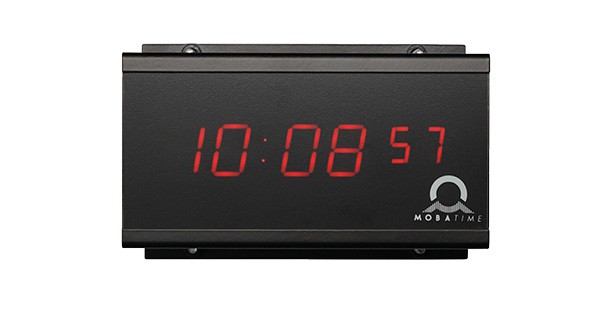Time Precision in Aviation

Introduction
In this article, we will continue to analyse the technical and operational aspects of timekeeping in the aviation industry, present the latest time synchronisation technologies and discuss what steps can be taken to further improve existing systems. This will not only increase safety and efficiency, but will also help prepare the aviation industry for new challenges.
Table of content
- The universal importance of weather and its fundamental role of time synchronization in aviation
- The essential role of time accuracy and synchronization at airports
2.1 The importance of synchronization of flight plans
2.2 Effects of precise measurement on ground traffic and terminal coordination - Time accuracy and synchronization in air traffic control
3.1 Influence of time synchronization on airspace safety
3.2 How is synchronization with MOBATIME ensured?
3.3 Products - What are the risks and consequences of deviations in the time synchronization of?
- Technological solutions and implementations
1. The universal importance of weather and its fundamental role of time synchronization in aviation
The universal importance of time goes far beyond everyday life and plays a crucial role in high-precision, safety-critical industries such as aviation. In airports and air traffic control, accurate time measurement is a fundamental aspect that influences safety, coordination and efficiency. In an environment where seconds can make or break the safety of hundreds of passengers, synchronization of timing systems is not a luxury, but a necessity.
The importance of precise synchronization cannot be underestimated. Every flight that takes off or lands, every movement on the runways, every coordination between air traffic controllers and pilots depends on precise and standardized coordination. This complex interaction between different actors, controlled by precise timing, ensures that global air traffic runs smoothly and without delays.
Accurate time synchronization not only helps to avoid collisions and increase safety, but also optimizes air traffic efficiency. Accurate schedules allow airlines to plan better and use resources more efficiently, resulting in lower operating costs and reduced environmental impact. Airports use accurate time to streamline the handling of aircraft, passengers and baggage, which increases customer satisfaction and improves the profitability of airport operators.
The challenges associated with maintaining time synchronization in such a dynamic environment as an airport are not trivial. Time discrepancies of even a few seconds can lead to misunderstandings, delays and, in extreme cases, security risks. It is therefore of paramount importance that timekeeping systems are highly reliable and supported by technologies that ensure a smooth and error-free time transfer.
2. The essential role of time accuracy and synchronization at airports
2.1 The importance of synchronization of flight plans
The synchronization of flight schedules is a fundamental requirement for maintaining order and efficiency at international and domestic airports. Precise synchronization of flight schedules allows airlines and airports to optimize their resources, minimize delays and maximize customer satisfaction. This starts with accurate planning of take-off and landing times, which must take into account not only runway availability, but also gate allocation and ground handling coordination.
Accurate time information is crucial to ensure that aircraft take off and land on schedule. Time deviations can cause a chain reaction that disrupts a day's entire flight schedule. This has a direct financial impact on airlines through increased operating costs and possible penalties for delays. It also directly affects passengers, whose connecting flights and other travel plans may be compromised.
The synchronization of flight plans requires advanced and coordinated technologies capable of processing real-time data from different sources. These systems must take into account not only timekeeping, but also the variability of weather conditions, air traffic and unpredictable events such as technical disruptions. The ability to respond quickly and accurately to such events is directly dependent on the reliability of time synchronization systems.
2.2 Effects of precise time measurement on ground traffic and terminal coordination
Accurate timekeeping has a significant impact on ground traffic and terminal coordination at airports. The coordination of ground vehicles, the movement of aircraft on the ground and the allocation of gates are highly sensitive tasks that require accurate timing. A delay of just a few minutes can cause congestion on taxiways and affect the operation of an entire terminal. Efficient ground traffic control reduces the risk of collisions, minimizes delays and improves overall flight safety. Precise timing allows ground traffic controllers to accurately monitor and effectively coordinate the movement of aircraft on the runways. This is especially important during peak hours when the number of aircraft on the ground is at its highest.
Terminal coordination also benefits from accurate time measurement. The allocation of check-in counters, security checkpoints and gate areas must be precisely planned to minimize waiting times and optimize passenger flow.
3. Time accuracy and synchronization in air traffic control

3.1 Influence of time synchronization on airspace safety
Time synchronization enables precise navigation and communication between aircraft and control towers and minimizes the risk of collisions. Precisely synchronized clocks allow air traffic control systems to determine the exact positions of aircraft and ensure that all aircraft movements are correctly coordinated. In a globally interconnected air traffic system, where fractions of a second determine the safety of flight manoeuvres, error-free time synchronization is indispensable. It helps to avoid delays and to ensure efficient flight paths, which significantly improves the overall safety of airspace.
3.2 How is synchronization with MOBATIME ensured?
Our NTP-controlled analogue and digital network clocks are ideal for use in airport facilities. They can be synchronized with any of our time servers or master clocks. These clocks automatically adjust to the correct time and can also be monitored remotely. As they are connected via LAN/WAN and run on Power over Ethernet (PoE), no additional infrastructure is required. This makes installation cost-effective and allows for flexible relocation.
Our two-wire clocks do not require any absolute time settings on the slave clocks. They have a self-adjusting time code and a permanent power supply for analogue models. No additional wiring is required for the power supply, although digital models may require an additional power connection. Two-wire installation is simple and cost-effective and supports a free-standing topology. Self-adjusting time code allows hundreds of clocks to be synchronized via a simple two-wire cable from a central master clock.
3.3 Products
4. What are the risks and consequences of deviations in the time synchronization of Airports?
If the time synchronization deviates, a number of problems can arise that can affect the integrity and performance of your projects. Here are some of the main risks and their consequences:
The main and most obvious consequence of timing errors is increased safety risk. In aviation, where seconds can determine safety distances between take-off and landing of aircraft, even small timing errors can pose major safety risks. An out-of-sync clock in air traffic control can lead controllers to give incorrect times, which in turn disrupts coordination between flights and, in the worst case, can lead to collisions. On the ground, similar timing errors in the systems responsible for ground vehicle control could lead to accidents on taxiways or at gates.
5. Technological solutions and implementations
The need for accurate time measurement that goes beyond standard solutions is clearly seen in the complex requirements of modern infrastructures such as airports and communication networks. Standard time measurement solutions often only offer the basics, which is sufficient for everyday applications. However, in critical application areas, where milliseconds can be crucial, these standard solutions are not sufficient. A good example of this is the reliance on GNSS (Global Navigation Satellite System), as explained in this article. Although GNSS provides a widely used and efficient timing method, it is susceptible to interference such as signal attenuation, artificial and natural jamming or even spoofing through signal interference.
These vulnerabilities illustrate why more advanced timing solutions are needed. These advanced systems often use redundant technologies to ensure greater reliability. For example, combining GNSS with other timing mechanisms, such as high-precision oscillators or innovative network synchronization services, can significantly increase the accuracy and reliability of timing. This type of redundant and extended timing ensures that critical systems continue to operate accurately, even in the event of GNSS failure, by seamlessly switching to an alternative timing source.
Would you like to find out more about this topic or do you need support with one of your projects?
Get in touch with us - we'll help you!





